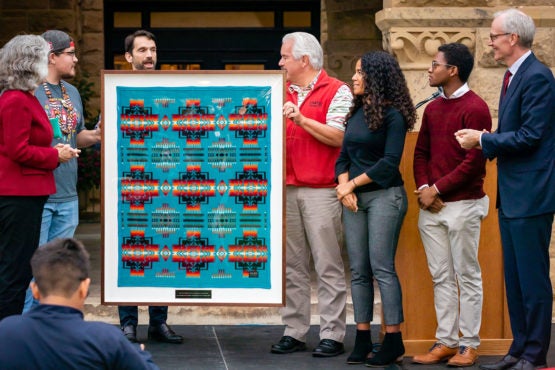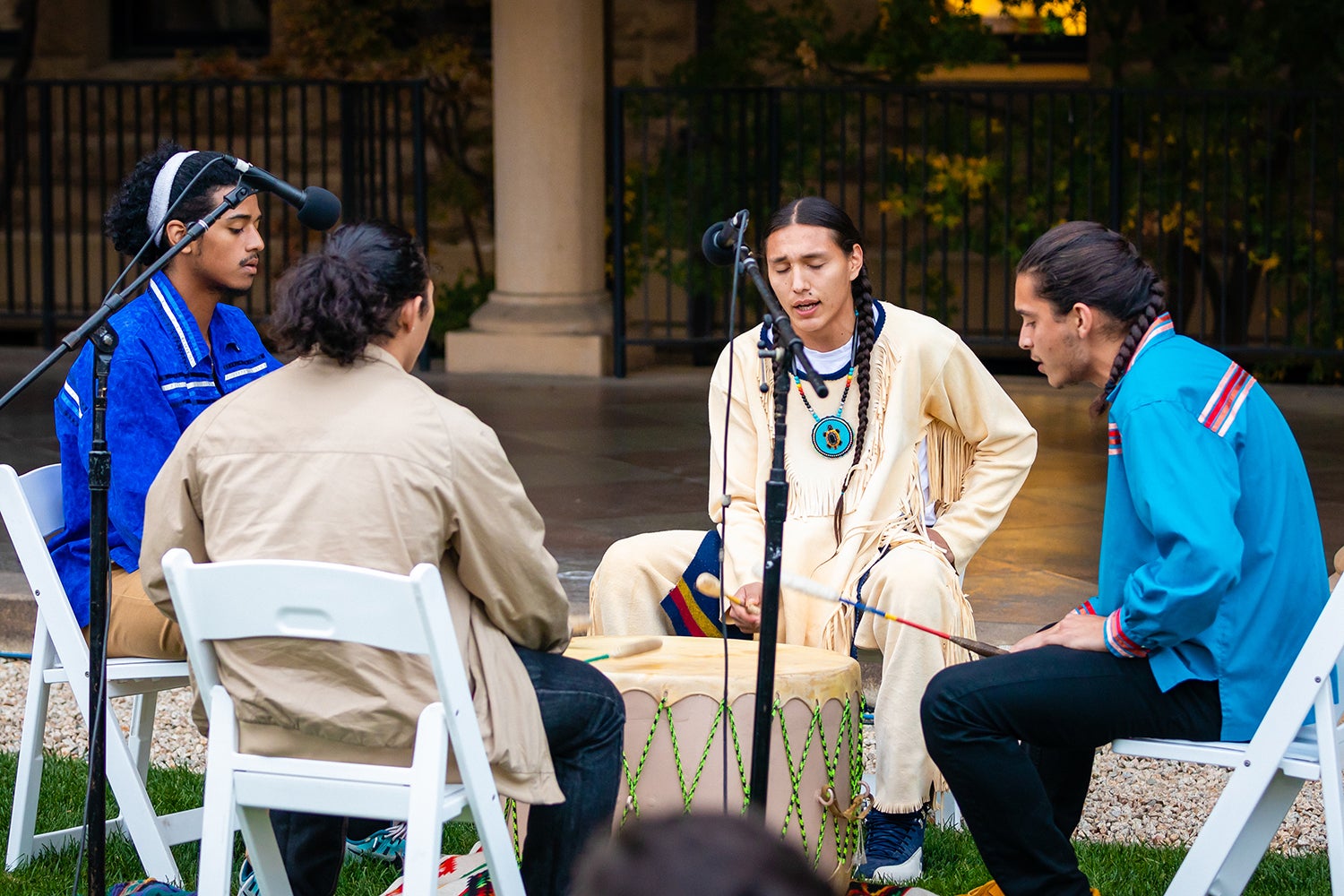Stanford completes the renaming process by dedicating Jane Stanford Way
Stanford dedicated Jane Stanford Way on Thursday, honoring the woman whose vision and leadership had a profound effect on the shaping of the university she co-founded with her husband, Leland. Leaders of the Muwekma Ohlone Tribe participated in the ceremony, welcoming the audience with prayer and song.

At the dedication Thursday, the Stanford American Indian Organization presented Stanford with a Pendleton blanket in gratitude for the renaming process. University leadership and leaders of the Associated Students of Stanford University accepted the gift. (Image credit: Farrin Abbott)
During Thursday’s ceremony to dedicate Jane Stanford Way, leaders of the Muwekma Ohlone Tribe welcomed the audience gathered in Memorial Court with a welcoming prayer and song delivered in Chochenyo, the language of their ancestors.
Charlene Nijmeh, chairwoman of the Muwekma Ohlone Tribe of the San Francisco Bay Area, greeted the audience, saying: “Ma’kkin Mak Muwekma. ‘Akkoy Mak-Warep, Manne Mak Hiswi,” or “We are Muwekma Ohlone. Welcome to our ancestral homeland.”
Nijmeh, who continued her address in English, said the tribe was honored to be invited to participate in the event.
The Muwékma Singers – including four children and three adults – sang a welcoming song. Their a cappella voices were accompanied by the rhythmic beating of elderberry clapper sticks as they performed in Memorial Court, a short distance from the newly named Jane Stanford Way.
The ceremony opened with a short address by Stanford student Dahkota Kicking Bear Brown, who noted that the land on which Stanford sits was, and continues to be, of great importance to the Ohlone people. The ceremony closed with four Stanford students beating a drum as they performed an honoring song.
In between, President Marc Tessier-Lavigne talked about the process the university used to rename campus landmarks bearing the surname of Father Junipero Serra (1713-1784), the founder of the California mission system, which contributed to the destruction of the cultural, economic and religious practices of indigenous communities.
Provost Persis Drell spoke of the life and times – and sometimes controversial decisions – of Jane Stanford, the woman whose vision and leadership had a profound effect on the shaping of the university she co-founded with her husband, Leland.
Approximately 125 people attended the ceremony commemorating the renaming of Serra Mall, a wide pedestrian and bicycle mall that runs across the front of campus, as Jane Stanford Way.
Jane Stanford’s legacy
In her address, Drell shared the well-known story of the university’s origins and the critical role Jane Stanford played to ensure it would endure for future generations.
When Jane and Leland Stanford’s only child, Leland Jr., died tragically of typhoid just two months shy of his 16th birthday, they made a commitment to “educating other people’s children” and used their wealth to establish Stanford. From the beginning, Jane Stanford took a very active role in its planning and management, Drell said.
In 1893, two years after the university opened, Leland Stanford died, creating serious financial problems for the fledging campus. Through her tenacity and willingness to make personal sacrifices, Jane Stanford guided the university through the next five very difficult years.
While Jane Stanford considered herself the “Mother of the University,” her decision to limit the number of female students to 500 was shocking – even at the time, Drell noted.
“She did, however, understand that her wealth put her in a position of power and privilege,” Drell said. “And, following the death of her son, she directed that power to a life of service to others, not only pouring herself into the university, but also supporting a wide range of causes and community projects that helped women, improved children’s education, protected orphans and expanded adult education opportunities.”
Drell said no one can deny Jane Stanford’s generosity, her devotion to the university and the students, and the bold vision she and Leland had for the university “to promote public welfare by exercising influence on behalf of humanity.” Drell said she was delighted that the university’s new official address is now 450 Jane Stanford Way.
“It’s about time to give this very humanly imperfect and totally remarkable woman her due,” she said.
A proud moment for Stanford
Tessier-Lavigne described the dedication of Jane Stanford Way as a “proud moment in this place and for our campus community,” and thanked those who had made the day possible, including the Native American community, and student and faculty leaders who called on the university to rename campus features bearing Serra’s name.
Stanford University launched a lengthy and complex process to examine the issue, which resulted in the renaming of three campus landmarks this year.
Tessier-Lavigne noted that the process enabled the university to honor two other women with distinct ties to Stanford.

Student drummers (left to right) Tai Anthony Buyco McMillan, Pilli Alfonso Cruz De-Jesus, David Espinoza and Ramiro Maxeechoga Hampson-Medina closed the ceremony with an honoring song. (Image credit: Farrin Abbott)
In April, Stanford renamed an undergraduate residence in the Stern Hall complex as the Sally Ride House in memory of pioneering astronaut and Stanford alumna Sally Ride. In May, Stanford renamed an academic building occupied by the Clayman Institute for Gender Research in honor of Stanford alumna and psychologist Carolyn Lewis Attneave, who was of Native heritage and is credited with establishing the field of Native American mental health. The renaming of Jane Stanford Way completes the process.
Tessier-Lavigne also noted that today, students and faculty come from around the world and from increasingly diverse backgrounds and experiences.
“We continue to explore ways to make sure that everyone has a voice and that all members of our community feel valued,” he said. “And with that comes an increasing awareness and recognition of the complex legacies that are associated with our campus and our history. Changing the name of Serra Mall to Jane Stanford Way is a meaningful, highly visible result of that awareness. And it is a recognition of continual change at Stanford.”
When she took the stage, Stanford student Caelin Marum greeted the audience in Cree, saying “tansī and tatawaw,” which translates to “hello and welcome into this space.”
“In the next year, we will be looking forward to the 50th anniversaries of the Stanford American Indian Organization and the Stanford Powwow, both of which were born out of student movements in much the same way as this renaming process,” said Marum, who is a co-chair of the Stanford American Indian Organization.
“As we approach this next chapter of our history, our sincerest hope is that this momentum can be a template for the future – one that reminds us to understand that the true gravitas of this occasion comes from both the tireless efforts of indigenous peoples and the cooperation of a non-indigenous administration who all believed in working to improve the experience of indigenous students in the future. As Stanford changes its official address to reflect respect and equity, we envision a future in which we all lead the institutions we are a part of to embrace the value-centered focus Stanford has taken in this process.”
To demonstrate the Native American community’s gratitude for the renaming process, Marum presented the university with a framed Pendleton blanket, which was accepted by Drell and Tessier-Lavigne, accompanied by two leaders of the Associated Students of Stanford University, President Erica Scott and Vice President Isaiah Drummond.
